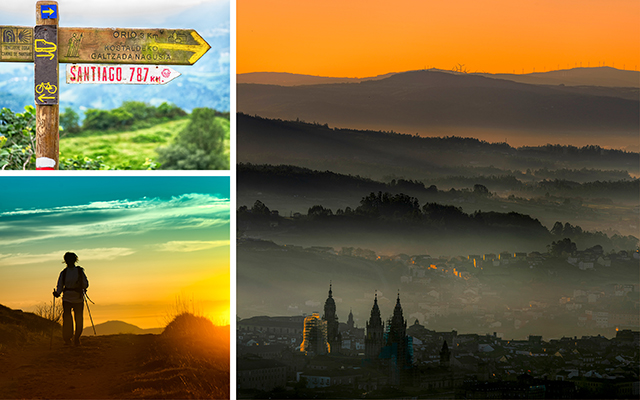Christian pilgrims have flocked to Santiago de Compostela since the Middle Ages. They travel to this city in northwestern Spain via multiple routes through charming Spanish and French villages to view the tomb of the apostle St. James the Greater. Regardless of where their journey begins, these travelers have typically viewed El Camino de Santiago as a path to spiritual growth.
Today, interest from hikers, cyclists, and tour groups have made the routes more popular than ever. In 2016, some 278,000 people received their official Compostela certificates proving they completed the pilgrimage.
Steve Cooper, 56, of Surrey, England, fondly recalls the breathtaking countryside from his 2014 trek with his wife. “I especially remember walking for two days through eucalyptus forests, with that amazing aroma that clears your head,” he says. “Arriving in Santiago de Compostela, it’s easy to feel in awe of the cathedral even if you’re not particularly religious.”
Bianca Esquivel, 29, is a veteran of six different pilgrimages. The Austin, Texas, native says her journeys “strip away” all the stuff in her inner and outer lives; living with just the necessities in a backpack has taught her the value of simplicity.
The pilgrimages have also exposed her to the benefits of joining a diverse community. In May 2017 she hiked 100 miles along the northern route of El Camino de Santiago as part of an interfaith, intergenerational peace pilgrimage with 15 other pilgrims from around the world. “We were Christian, Muslim, Hindu, or simply seekers and believers in something greater than ourselves,” she says.
Though group members were strangers, Esquivel says they cherished the opportunity to interact in meaningful ways. They told their life stories; celebrated aspects of their spirituality; practiced yoga, dance, and meditation; and walked together in silence for an hour each day. “In a world increasingly focused on what makes us different — rather than celebrating our differences — the 16 of us became a family,” she explains.
“A pilgrimage is an experience where people can come together and leave behind the differences that divide them,” agrees travel writer and Episcopal deacon Lori Erickson, 56, of Iowa City, Iowa. “You’re left with invisible ties that bind you to other seekers.”
Eye-Opening Excursions
Unlike a vacation, “a pilgrimage is both an outer and an inner journey,” explains Erickson, who chronicles her visits to a dozen holy sites in Holy Rover: Journeys in Search of Mystery, Miracles, and God.
“You’re not just going to a beach to relax and unwind; you’re going to learn things,” she says. “It’s a trip with the component of being able to change your heart and expand your mind.”
Throughout history, pilgrims seeking personal transformation have been drawn to religious sites, such as Mecca, Sravasti, Mahamaham, and Jerusalem. But they’ve also sought places of great beauty to spark a renewed spirit.
These life-altering excursions aren’t just for the religious. “It’s a mistake to put pilgrimages into too small of a box,” Erickson adds. “One of the big things I’ve learned from visiting so many sacred places is that it’s unexpected what catches people’s imagination and makes them open to this sort of transformative experience.”
“A pilgrimage leaves you with invisible ties that bind you to other seekers.”
Kate Barrett, 45, mission chair for Catholic identity at St. Catherine University in St. Paul, Minn., understands the importance of walking the pilgrim path. She is creating a pilgrimage for faculty and staff to visit Le Puy-en-Velay, France, where six women founded the Sisters of St. Joseph, an all-woman congregation, in 1650. Because the number of women becoming nuns has dropped significantly in recent years, the trip is key to sustaining the sisters’ beliefs, spirit, and stories — but it’s also a way to help them feel part of something bigger than themselves.
“Pilgrims visit the site of the original hearth where the first sisters — who were some of the first nuns not to be cloistered — gathered to talk about their days and the community’s needs,” Barrett explains. “This process — known as ‘sharing the heart’ — along with a strong focus on responding to the needs of the time, are still the bedrock of the St. Catherine community.”
Le Puy isn’t the only place of nourishment and shelter that Barrett has visited. She experienced one unexpectedly while working as a camp counselor in Minnesota’s stunning Boundary -Waters Canoe Area Wilderness.
“The weather turned and we struggled to make our way to the nearest island to find refuge. We pulled our -canoes out and collapsed,” she recalls. “A short while later, I noticed a blueberry. Then I noticed the site was covered with them. It was magical.” Barrett and several friends return to the awe-inspiring “blueberry island” whenever they’re in the area to commune with one another in this special place.
Paths to History
Literature is overflowing with tales about individual rites of passage. Pilgrim stories overlap with literary categories, from romance to satire. Some — like Geoffrey Chaucer’s Canterbury Tales — became canonical texts acclaimed for sharing the lives of common characters living in 14th-century England. Recent bestsellers such as Wild: From Lost to Found on the Pacific Crest Trail; Eat, Pray, Love; and Into the Wild have captured the popular imagination.
No matter the era in which they were written, these tales of courage, communion, and healing have inspired legions of readers, including Susana Lopez, to undertake inspiring journeys of their own.
Lopez, 23, has been obsessed with British literature since her grade-school days. She chose to study English at Mills College in Oakland, Calif., so she could immerse herself in the writings of William Shakespeare, Jane Austen, and John Keats.
Spending a summer in Brighton, England, exploring the seaside and countryside towns where her favorite authors lived, Lopez experienced the environment they described in their plays, poems, and novels. She fell in love with the land, but it was during a visit to London’s world-famous Globe Theatre that she felt an overwhelming sense of awe and majesty.
“It was a realization of a dream I’d had since first reading Shakespeare’s sonnets and watching Shakespeare in Love,” she says. “I came out of the experience with not only more appreciation for theatrical productions, but also with a sense that I was able to participate in living history.”
Family Connections
Many people undertake pilgrimages to satisfy a curiosity about their family history. Glenna Goldman, 26, of Des Moines, Iowa, recalls a memorable visit to her family’s ancestral home on Norway’s Dønna Island. The locale offers breathtaking views of rugged mountains and sparkling seas, but it was connecting with her roots that made the trip so special.
“I met a lot of relatives I never knew I had,” Goldman says. “It was thought provoking knowing that if circumstances were different, I might have grown up Norwegian.”
To celebrate her 60th birthday, Kim Barlow trekked from her home in Grayslake, Ill., to Carthage, Ill., to explore her past. “My family moved just a few months after I was born, so I never knew my birthplace,” she explains. A senior center stands on the site where the hospital was, but she found plenty of memorabilia, including the hospital entryway and photos at the town’s museum.
Barlow also visited nearby Plymouth and Augusta to see the homes where her family had lived and the school where her father had worked. “We were able to check out all sorts of local historic sites and stay in an amazing old inn,” she says. “I feel like a more complete person now that I’ve filled in that missing bit of my personal and family history.”
Local Quests
Pilgrimages don’t have to involve extended journeys to distant places. These popular destinations may be closer to home.
Graceland: Memphis, Tenn.
More than 500,000 music fans flock to this iconic mansion every year to pay homage to the King of Rock-and-Roll. Guests can tour the home and museums, view special exhibits, and spend time in the meditation garden beside the graves of Elvis Presley and members of his family. www.graceland.com
Abbey of Gethsemani: Trappist, Ky.
Since its founding in 1848, the abbey has received guests from all over the world who come to participate in silent retreats. Thomas Merton resided at the monastery for 27 years, and fans can visit the place where he wrote prolifically on topics that include the contemplative life, race relations, and nuclear war. www.monks.org
John Muir Trail: California
Each summer, hikers follow in the footsteps of the famous conservationist. The route — which takes about 30 days to complete — begins in Yosemite National Park and continues for 200 miles through some of the most beautiful backcountry in the Sierra Nevada Mountains, ending at Mount Whitney. www.johnmuirtrail.org
Sedona, Ariz.
Known for energy vortexes that have been part of sacred Navajo, Yavapai, and Hopi ceremonies for centuries, Sedona has long been a place of retreat. Exploring the red-rock buttes and taking a class at the Sedona Metaphysical Spiritual Association provide oppor-tunities to enrich the spirit. www.visitsedona.com




This Post Has 0 Comments